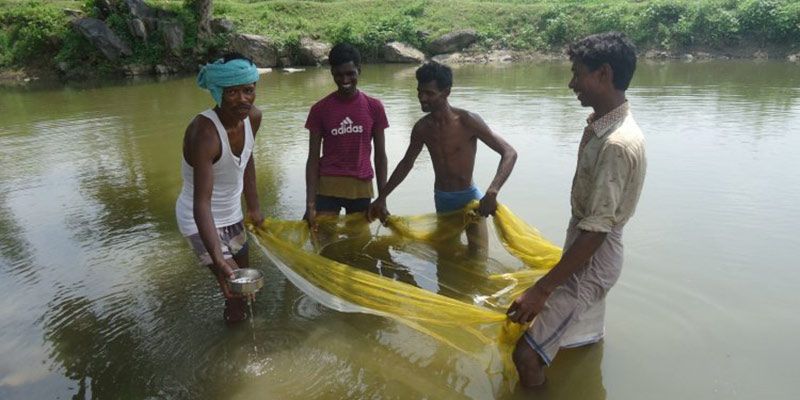Small-scale fishworkers cast net elsewhere for jobs
Fishers livelihoods are being directly threatened by mechanised fishing methods and ecologically-destructive fishing practices.
Chinna, 35, harvests fish and is engaged on a piece-rate basis by the local contractor who has rights to fishing in the village tank in Anantapur, Andhra Pradesh. At times, China also uses family labour to complete his work. A bestha by caste, he is witnessing rapid changes in his livelihood in places like his village where long-established fishing communities exist as their right to livelihood is significantly dependent on establishing the right of the communities over water resources--tankwater, in this case.
Chinna does semi-mechanised fishing but senses that, of late, fishing methods have been mechanised, production processes industrialised and markets globalised leading to over-utilisation of resources. “This, in turn, is leading to marginalisation of traditional fishing methods and subsequently of the fishing communities like mine," he says. And as the common narrative goes in most Indian villages, people from his caste are opting to migrate out in search of better livelihoods.

Overview of the fisheries sector
Fisheries, an important sub-sector of Indian agriculture, and is dependent on the country’s rich marine and inland water resources. Forty-seven percent of fish production is from along India’s 8,118kmlong coastline. The rest (53 percent) is from inland water resource that “comprises 45,000km of rivers and streams and 1.6 million hectares of freshwater lakes, ponds and swamps”.
The fisheries sector, through sale of relatively high-value produce, has grown at an average annual rate of four percent in the last five years. Fish and fish products constitute 20 percent of the national agriculture exports and have been contributing about 1.07 percent of the country’s total Gross Domestic Product. The sector makes up 20 percent of the national agriculture exports.
An important source of employment, the sector is estimated to provide livelihoods to about 14.5 million people apart from being an important source of nutrition. Per the Handbook on Fisheries Statistics (2014), 46.5 percent fishworkers were engaged full time in fishing operations while the remaining were part-time workers. Nearly 75 percent of India’s fishworkers fish in rivers, reservoirs, lakes and other inland waters, while the rest depend on marine resources as per Indian Livestock Census, 2003.
A range of employments are based on the sector--capture and culture of fish from sea and inland waters, backyard pond management, fabrication of fishing gears and baskets, breeding, processing like preparation of frozen fillets, fish marketing, export and import of fish and fish products, fisheries research, education and related activities. However, with the sector undergoing changes, a tide of unemployment is swelling among fishworkers.
Small-scale fisheries
An important characteristic of India’s fisheries sector is its small-scale nature. “Besides being a source of protein-rich nutritious food, income and livelihood to poor fishers, the fisheries sector is important for engaging the rural population in a number of ancillary activities such as marketing, retailing, transportation, etc.,” states a Working Group report by the Planning Commission. Small-scale fisheries are generally marked by skill-intensive operations where small craft and simple gear techniques are used.
Research points out that in the backdrop of globalisation, the small-scale fisheries sector’s “earlier sense of resilience, cohesion and community seemed to be waning”. The rapid growth of fleet size, fishing gears and engine power is leading to ecologically-destructive fishing practices. Marine and inland fishing stocks are getting depleted and fish breeding locations destroyed. “Coastal areas are increasingly marked by shoreline changes and destruction of fish habitats and sensitive ecosystems”. And with this, the sector is increasingly seeing a move away from short fishing trips and small fishing vessels operated by small-scale fishers using less capital and energy.
The impact on the sector and its workers will be through “falling productivity, species migration and localised extinctions, as well as conflict over the use of scarce resources and increased risks associated with more extreme climatic events”. Fish as well as the ecosystems on which they depend will be affected, with the result that small-scale fishers are faced with declining access to fishing systems and markets, and the inability to pay for investments as well as reduced returns.
Coping with uncertainties
Small craft and simple gear are on the decline. So are fishing methods developed over centuries, appropriate to the fish as well as environment. A paper by Venkatesh Salagrama notes how millions of fishers and fishworkers who have been depending on the waters through generations are coping with increasing uncertainty and fluctuating incomes. The shareworkers or owner-operators of the small-scale fisheries units have very poor employment mobility out of fishing.
In the eastern coast like in Andhra Pradesh and West Bengal, Salagrama notes that the “fishworkers are fishing less and diversifying into several activities ranging from working as fishing crew in other states in the west coast to unskilled, low-paying, non-fisheries occupations within and beyond their area”. The paper further notes that “on the west coast, the increasing uncertainty leads to a strategy to survive by fishing, for example, by investing more in the activity in order to go farther out into the sea and catch more fish.” The long-term implication of fishing more remains uncertain.
The same paper states, “Some of the coping strategies adapted by the fishworkers to cope with uncertainties is by way of diversification in terms of targeted fish and fishing grounds; changes to fishing duration and fishing systems, usage of migrant workers and technological innovations, alongside other cost-saving measures; and changing ownership and sharing patterns”.

Women in the fisheries sector
The labour force in the fisheries sector comprises 46 percent females as per the Livestock Census, 2003. Besides, wherever men are engaged in self employment in small-scale fisheries, family labour is commonly resorted to. Historically, there has been a gender-based division of labour in the sector with women being mostly employed in handling of the fish, simple indigenous methods of fish processing like salting, drying, in the making of nets and in retail sale of fish in various markets. Of late, women are also being engaged in modern fish processing units. In fact, certain activities like prawn peeling that is a labour intensive activity is done exclusively by women. While women have faced problems in their traditional role of fish marketing and processing, the traditional fisherwoman has been marginalised further these days and has “lesser access to the resources due to the advent of mechanisation in fishing, net making, etc., and the entry of big businessmen into the field. Also, the personal relationship between the fisherwoman and other market intermediaries has changed to a business-like one”.
Difficulties in introducing small scale fisheries
Together the inland and coastal small-scale fisheries can, with cross-sectoral interventions, significantly improve the livelihoods of fish-dependent communities. However, there are problems in promoting small-scale fisheries as a self employment option among non-traditional fishing communities.
Four years ago, in Jharkhand, when Vikas Sahyog Kendra, an NGO based at Palamau district began to work with communities on promoting small scale fisheries as a livelihood option, it realised that control over large water bodies was still under threat of contractors. Scientific fisheries was still a new concept for people to understand and government efforts to provide training were inadequate. Fingerling production was not localised and the quality of seeds was poor. Infrastructure like boats, tubes and fishing nets were not available with farmers who procured it from mallahs who charged a third of the produce during harvesting. Harvesting skills of the farmer turned fishers were also not up to the mark. Government supported local hatcheries were still picking up in the area, and production was not able to meet local demand. Also, fisheries in inland water-bodies, which have multiple uses often, get least priority, the higher priority being agriculture and industry.
While interventions like these are noteworthy, a comprehensive strategy to protect the lives and livelihoods of fishworkers is required especially given the stiff competition from developed countries which have put strict quality and safety standards and non-tariff barriers threatening the survival of the small-scale fisheries sector. A lot needs to be done in terms of institutional responses to deal with the downturn in this sector. The capacity of fishworkers organisations needs to be greatly strengthened.
Disclaimer: This article, authored by Amita Bhaduri, was first published on India Water Portal.The views expressed by the author are his own and do not necessarily reflect that of YourStory’s.











